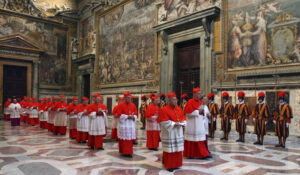
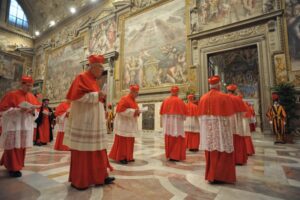
Election of Pope 2
This handout picture released by the Vatican Press Office on March 12, 2013 shows cardinals following a grand mass at the St Peter’s basilica before the start of a papal election conclave on March 12, 2013 at the Vatican. Cardinals moved into the Vatican today as the suspense mounted ahead of a secret papal election with no clear frontrunner to steer the Catholic world through troubled waters after Benedict XVI’s historic resignation.
Before the sealing of the Sistine Chapel
The cardinals hear two sermons before the election: one before actually entering the conclave, and one once they are settled in the Sistine Chapel. In both cases, the sermons are meant to lay out the current state of the Church, and to suggest the qualities necessary for a pope to possess in that specific time. The first preacher in the 2005 conclave was Fr. Raniero Cantalamessa, the preacher of the papal household and a member of the Capuchin Franciscan order, who spoke at one of the meetings of the cardinals held before the actual day when the conclave began. CardinalTomáš Špidlík, a former professor at the Pontifical Oriental Institute and a non-voting member (due to age) of the College of Cardinals, spoke just before the doors were finally closed for the conclave.
On the morning of the day designated by the Congregations of Cardinals, the cardinal electors assemble in St Peter’s Basilica to celebrate theEucharist. Then, they gather in the afternoon in the Pauline Chapel of the Palace of the Vatican, proceeding to the Sistine Chapel while singing theLitany of the Saints. The Cardinals will also sing the Veni CreatorSpiritus[70] then take an oath to observe the procedures set down by the apostolic constitutions; to, if elected, defend the liberty of the Holy See; to maintain secrecy; and to disregard the instructions of secular authorities on voting. The Cardinal Dean reads the oath aloud in full; in order of precedence (where their rank is the same, their birthdate is taken as precedence), the other cardinal electors repeat the oath, while touching the Gospels. The oath is as follows:
Et ego, (first name), Cardinalis (surname), spondeo, voveo, ac iuro. Sic me Deus adiuvet et haec Sancta Dei Evangelia, quae manu mea tango.
(And I, (name) Cardinal, (name), promise, vow and swear. Thus, may God help me and these Holy Gospels which I touch with my hand.) [71][72]
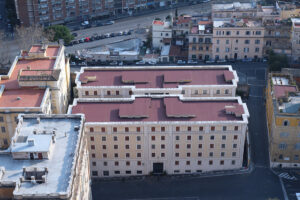
Domus Sancta Martha
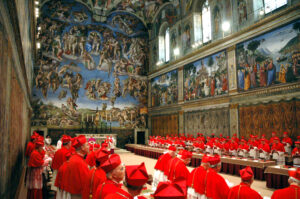
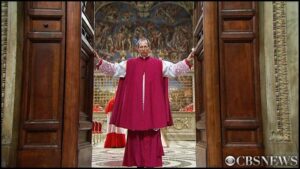
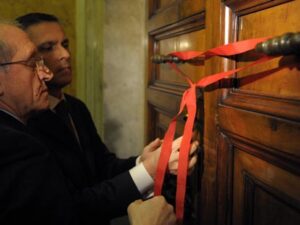

Expelling the outsiders
After all the cardinals present have taken the oath, the Master of the Papal Liturgical Celebrations orders all individuals other than the cardinals electors and conclave participants to leave the Chapel. Traditionally, he stands at the door of the Sistine Chapel and calls out: “Extra omnes!” (Latin for, roughly, “Everybody else, out!”) He then closes the door.[73] In modern practice, the Master of the Papal Liturgical Celebrations does not have to stand at the door of the Sistine Chapel—during the 2013 conclave, the Master Guido Marini stood in front of the altar and gave the command and only went to the chapel doors to close them after the outsiders had left.[74]
The Master himself may remain, as may one ecclesiastic designated by the Congregations prior to the commencement of the election. The ecclesiastic makes a speech concerning the problems facing the Church and on the qualities the new pope needs to have. After the speech concludes, the ecclesiastic leaves. Following the recitation of prayers, the Cardinal Dean asks if any doubts relating to procedure remain. After the clarification of the doubts, the election may commence. Cardinals who arrive after the conclave has begun are admitted nevertheless. An ill cardinal may leave the conclave and later be readmitted; a cardinal who leaves for any reason other than illness may not return to the conclave.[75]
Although in the past cardinal electors could be accompanied by attendants (“conclavists“), now only a nurse may accompany a cardinal who for reasons of ill-health, as confirmed by the Congregation of Cardinals, needs such assistance.[4] The Secretary of the College of Cardinals, the Master of Papal Liturgical Celebrations, two Masters of Ceremonies, two officers of the Papal Sacristy and an ecclesiastic assisting the Dean of the College of Cardinals are also admitted to the conclave. Priests are available to hear confessions in different languages; two doctors are also admitted. Finally, a strictly limited number of servant staff are permitted for housekeeping and the preparing and serving of meals.
Secrecy is maintained during the conclave; the cardinals as well as the conclavists and staff are forbidden to disclose any information relating to the election. Cardinal electors may not correspond or converse with anyone outside the conclave, by post, radio, telephone, internet and social media, or otherwise and eavesdropping is an offense punishable by excommunication latae sententiae. Only three cardinals electors are permitted to communicate with the outside world under grave circumstances, prior to approval of the College, to fulfil their duties: the Major Penitentiary, theCardinal Vicar for the Diocese of Rome, and the Vicar General for the Vatican City State.[4]
Before the conclave that elected Pope Francis, the Sistine Chapel was “swept” using the latest electronic devices to detect any hidden “bugs” or surveillance devices (there were no reports that any were found, but in previous conclaves press reporters who had disguised themselves as conclave servants were discovered). Universi Dominici gregis specifically prohibits media such as newspapers, the radio, and television.[76] Wi-Fiaccess is blocked in Vatican City and wireless signal jammers are deployed at the Sistine Chapel to prevent any form of electronic communications to or from the Cardinal electors.[77]
Electorate
As the Christian communities became established they started to elect bishops, chosen by the clergy and laity of the community with the assistance of the bishops of neighbouring dioceses. St. Cyprian says that Pope Cornelius was chosen Bishop of Rome “by the decree of God and of His Church, by the testimony of nearly all the clergy, by the college of aged bishops [sacerdotum], and of good men.” As was true for bishops of other dioceses, the clergy of the Diocese of Rome was the electoral body for the Bishop of Rome. Instead of casting votes, the bishop was selected by general consensus or by acclamation. The candidate would then be submitted to the people for their general approval or disapproval. This lack of precision in the election procedures occasionally gave rise to rival popes or antipopes.
The right of the laity to refuse the person elected was abolished by a Synod held in the Lateran in 769, but restored to Roman noblemen by Pope Nicholas I during a Synod of Rome in 862. The pope was also subjected to oaths of loyalty to the Holy Roman Emperor, whose task it was to provide security and public peace in Rome. A major change was introduced in 1059, when Pope Nicholas II decreed in In Nomine Domini that the cardinals were to elect a candidate, who would take office after receiving the assent of the clergy and laity. The cardinal bishops were to meet first and discuss the candidates before summoning the cardinal priests and cardinal deacons for the actual vote. The Second Council of the Lateran in 1139 removed the requirement that the assent of the lower clergy and the laity be obtained, while the Third Council of the Lateran in 1179 gave equal rights to the entire College of Cardinals when electing a new pope.
Through much of the Middle Ages and Renaissance there were a small number of cardinals, down to as few as seven under either Pope Alexander IV[15] or Pope John XXI.[16][17] Difficult travel further reduced the number arriving at the conclave. With a small electorate an individual vote was significant, and was not easily shaken from familial or political lines. Conclaves could last months and even years. In addition to the decree in 1274 that the electors should be locked in seclusion, Gregory X also limited each cardinal elector to two servants, and rationed their food progressively on the fourth and ninth days should they fail to elect a new pope.[12] The strict rules of the conclave were disliked by the cardinals and temporarily suspended by Pope Adrian V in 1276 before being formally revoked by John XXI’s Licet felicis recordationis later that same year, both of whom had intended to promulgate new constitution governing papal election but died before doing so.[16][18] Lengthy elections resumed and continued to be the norm until 1294, when a Benedictine hermit was elected Pope Celestine V. Celestine reinstated the strict conclave, but soon resigned the papacy.[19]Long interregna occurred after the reinstatement of the conclave: in 1314–1316 during the Avignon Papacy, where the original conclave were dispersed by besieging mercenaries and not reconvened until almost two years had passed;[20] and in 1415–1417, as a result of the Western Schism.
In 1587, Pope Sixtus V limited the maximum number of cardinals to 70, following the precedent of Moses who was assisted by 70 elders in governing the Children of Israel: six cardinal bishops, 50 cardinal priests, and 14 cardinal deacons.[15] Beginning with Pope John XXIII‘s attempts to broaden the representation of nations in the College of Cardinals, that number has increased. In 1970, Paul VI decreed that cardinals upon reaching the age of eighty before a conclave start were ineligible to vote in the conclave, and also increased the limit of active cardinal electors to 120.[21][22] Though this remains the theoretical limit, John Paul II exceeded this for short periods of time with knowledge of impending retirements. John Paul II also specified that cardinals who are under eighty before the day the Holy See becomes vacant would still be entitled to vote even if they had turned eighty by the time the conclave starts.[4]
Choice of electors
Originally, lay status did not bar election to the Bishop of Rome. Bishops of dioceses were sometimes elected while still catechumens, such as the case of St. Ambrose.[23] In the wake of the violent dispute over the election of Antipope Constantine II, Pope Stephen III held the synod of 769 which decreed that only a cardinal priest or cardinal deacon could be elected specifically excluding those that are already bishops.[11][24] This was however deviated from as early as 817 and fully ignored from 882 with the election of Pope Marinus I, the Bishop of Caere.[25] Nicholas II, in the synod of 1059, formally codified existing practise by decreeing that preference were to be given to the clergy of Rome, but leaving the cardinal bishops free to select a cleric from elsewhere if they so decided.[26] These restrictions on eligibility were rescinded by the Council of 1179.[14]
Pope Urban VI in 1378 was the last pope elected from outside the College of Cardinals. The last person elected as pope who was not already an ordained priest or monk was Pope Leo X in 1513, who was also the youngest pope ever elected.[citation needed] His successor, Pope Adrian VI, was the last to be elected in absentia.[27] In more recent history it is reported that Archbishop Giovanni Montini of Milan received several votes in the 1958 conclave despite not being a cardinal.[26] The newly elected John XXIII elevated Montini to the cardinalate almost immediately,[28] and would be succeeded by him as Paul VI in 1963. As the Catholic Church holds that women cannot be validly ordained, women are not eligible for the papacy.[29] Claims that there was a female pope, including the legendary Pope Joan, are fictitious.[30][31] This tale began as a satire on the deplorable state of corruption in the College of Cardinals; things were so bad, even a woman could be elected Pope. Though the pope is the Bishop of Rome, he need not be of Italian background. The current pope, Francis, is an Argentinian while his predecessor, Benedict XVI, is a German and before him was John Paul II, a Pole.
A simple majority vote sufficed for election until 1179, when the Third Council of the Lateran increased the required majority to two-thirds.[14][32] As cardinals were not allowed to vote for themselves (after 1621), an elaborate procedure was adopted to ensure secrecy while at the same time preventing self voting.[33] In 1945, Pope Pius XII removed the prohibition on a cardinal voting for himself by increasing the requisite majority to two-thirds plus one at all times.[34] This change was immediately overturned by his successor John XXIII who reinstated the two-thirds majority if the number of cardinal electors voting is divisible by three, with a rounding up to two-thirds plus one otherwise.[35] Pius XII’s rule was reinstated by Paul VI thirteen years later,[22] but overturned again by John Paul II. In 1996, John Paul II’s constitution allowed election by absolute majority if deadlockprevailed after thirty three or thirty four ballots.[4][36] In 2007 Benedict XVI rescinded John Paul II’s change, which had been criticised as effectively abolishing the two-thirds majority requirement, as any majority would suffice to block the election until a simple majority was enough to elect the next pope, reaffirming the requirement of a two-thirds majority.[8][9]
Electors formerly made choices by accessus, acclamation (per inspirationem), adoration, compromise (per compromissum) or scrutiny (per scrutinium).[10] With acclamation, the cardinals would unanimously declare the new pope quasi afflati Spiritu Sancto (as if inspired by the Holy Spirit).[34] If this took place before any formal ballot has taken place, the method was called adoration,[37] but this method was excluded in 1621 byPope Gregory XV.[38][39] To elect by compromise, a deadlocked College would unanimously delegate the election to a committee of cardinals whose choice they all agree to abide by.[34] Scrutiny is election via the casting of secret ballots. Accessus was a method for cardinals to change their most recent vote to accede to another candidate in an attempt to reach the requsite two-thirds majority and end the conclave. This method was first disallowed by the Cardinal Dean at the 1903 conclave.[10] The last election by compromise is considered to be that of Pope John XXII in 1316, and the last election by acclamation that of Pope Innocent XI in the 1676 conclave.[40] The long unused methods of acclamation and compromise were formally abolished in Universi Dominici gregis. Scrutiny is now the only approved method for the election of a new pope.[4]
Secular influence
For a significant part of its history, the Church was influenced in the choice of its leaders by powerful monarchs and governments. For example, theRoman emperors once held considerable sway in the elections of popes. In 418, Honorius settled a controversial election, upholding Pope Boniface Iover the challenger Antipope Eulalius. On the request of Boniface I, Honorius ordered that in future cases, any disputed election would be settled by a fresh election.[41] After the demise of the Western Roman Empire, influence passed to the Ostrogothic Kings of Italy and in 533, Pope John IIformally recognised the right of the Ostrogothic monarchs to ratify elections. By 537, the Ostrogothic monarchy had been overthrown, and power passed to the Byzantine emperors. A procedure was adopted whereby officials were required to notify the Exarch of Ravenna upon the death of a pope before proceeding with the election.[42] Once the electors arrived at a choice, they were required to send a delegation to Constantinoplerequesting the emperor’s consent, which was necessary before the individual elected could take office. Lengthy delays were caused by the journey to and from Constantinople.[43] When Pope Benedict II complained about them, Emperor Constantine IV acquiesced, ending the requirement that elections be confirmed by emperors. Thereafter, the Emperor was only required to be notified.[44] The last pope to notify the Byzantine emperors wasPope Zachary in 741.[45]
In the 9th century, the Holy Roman Empire came to exert control over the elections of popes. While Charlemagne and Louis the Pious did not interfere with the Church, LothairI claimed that an election could only be conducted in the presence of imperial ambassadors.[46] In 898, riots forcedPope John IX to recognise the superintendence of the Holy Roman Emperor.[47][48] At the same time, the Roman nobility also continued to exert a great influence, especially during the tenth century period known as saeculum obscurum (Latin for “the dark age”).[49]
In 1059, the same papal bull that restricted suffrage to the cardinals also recognised the authority of the Holy Roman Emperor, at the time Henry IV, but only as a concession made by the pope, declaring that the Holy Roman Emperor had no authority to intervene in elections except where permitted to do so by papal agreements.[26] Pope Gregory VII was the last to submit to the interference of the Holy Roman Emperors. The breach between him and the Holy Roman Empire caused by the Investiture Controversy led to the abolition of the Emperor’s role.[50] In 1122, the Holy Roman Empire acceded to the Concordat of Worms, accepting the papal decision.[51]
From about 1600, certain Catholic monarchs claimed a jus exclusivae (right of exclusion), i.e. a veto over papal elections, exercised through a crown-cardinal. By an informal convention, each state claiming the veto was allowed to exercise the right once per conclave. Therefore, a crown-cardinal did not announce the veto until the very last moment when the candidate in question seemed likely to get elected. This was however not strictly enforced, as Francis II through František de Paula Hrzán z Harasova is known to have exercised the veto twice at the 1799–1800 conclave.[52] No vetoes could be employed after an election. After the Holy Roman Empire was dissolved in 1806, its veto power devolved upon the Austrian Empire. The last exercise of the veto was in 1903, when Prince Jan Puzyna de Kosielsko informed the College of Cardinals that Austria opposed the election of MarianoRampolla. Consequently, the College elected Giuseppe Sarto as Pope Pius X, who issued the papal bull Commissum nobis six months later declaring that any cardinal who communicated his government’s veto in the future would suffer excommunication latae sententiae.[53][54]

